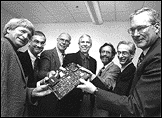It's in the Air, It's Everywhere
New Wireless Research Center Aims to Put a Radio in Your 21st-Century Toaster
By Robert Sanders, Public Affairs
Posted February 3, 1999
 Taking part in the center dedication were (from left) EECS professor and co-director Jan Rabaey; Patrick Scaglia, vice president for research at Cadence Design Systems, representing the center's seven major corporate sponsors; Jack McCredie, associate vice chancellor for Information Systems and Technology; EECS professor and co-director Bob Brodersen; technical director Gary Kelson; EECS department chair Randy Katz; and Dean Paul Gray of the College of Engineering. Peg Skorpinski photo. |
But the Berkeley Wireless Research Center -- which opened its doors Jan. 29 -- is setting its sights on improving wireless for the generations to come. Its goal is to develop the technology for the 21st Century's wireless revolution, which will allow complete radio systems to be put on a single computer chip.
"The new wireless center represents a unique approach to create a better, more effective partnership with industry," said College of Engineering Dean Paul Gray, a participating faculty member. "Having university faculty and graduate students working closely with industry people has tremendous potential for advancing the basic techniques needed to implement wireless communications systems."
The center was dedicated by Associate Vice Chancellor for Information Systems & Technology Jack McCredie, the College of Engineering, faculty and student researchers and the supporting companies.
Its research goals include creating universal radios that efficiently share scarce space in the radio frequency spectrum; designing tiny, cheap "picoradios" that can be embedded into every household appliance, adapt to any network and have a battery life of years; and developing ultra-high frequency radios that will allow inexpensive use of now unused regions of the frequency spectrum.
Six corporations that today lead the world in wireless communications are supporting the center, along with several million dollars in government research funding from the Defense Advanced Research Projects Agency (DARPA). Each of the industrial members has donated equipment and contributed $450,000 over three years to create the center at Shattuck Avenue and Allston Way.
The center will house 40 to 60 researchers from campus, other universities and from industry, including graduate and undergraduate students and seven faculty from the Department of Electrical Engineering and Computer Sciences.
"The center will concentrate on areas far ahead of present corporate developments, which is one of the reasons that it is necessary to have such tight industry interaction," said Gary Kelson, technical director of the center.
"The sponsors are all world-class companies, and we want this to be a world-class facility with research that fundamentally changes the nature of wireless communications," Kelson said.
![]()
![]()
February 3 - 9, 1999 (Volume 27, Number 21)
Copyright 1999, The Regents of the University of California.
Produced and maintained by the Office of Public Affairs at UC Berkeley.
Comments? E-mail berkeleyan@pa.urel.berkeley.edu.